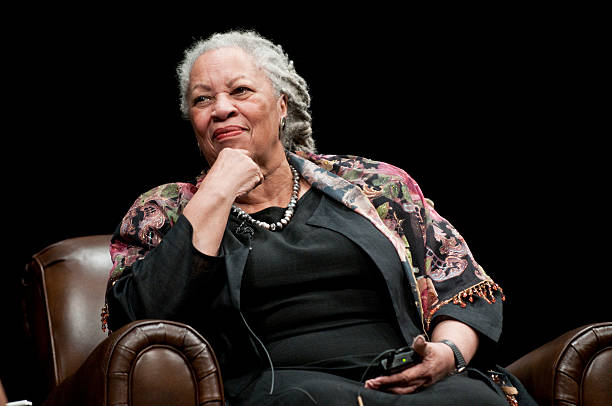(ThyBlackMan.com) Toni Morrison remains one of the most powerful voices in American literature, with her works transcending mere storytelling to examine the complexities of African American life, identity, history, and resilience. Born in 1931, Morrison’s background as a Black woman in the United States shaped her literary vision, as she worked to bring the narratives and struggles of African Americans to the forefront. Her novels, celebrated for their poetic language and haunting prose, tackle profound themes such as memory, trauma, and communal identity, leaving a lasting impression on readers and critics alike.
Morrison’s novels reflect her dedication to truthfully portraying Black experiences without catering to the comfort of wider audiences unfamiliar with that history. As a result, her work is imbued with raw emotional power and unapologetic honesty, challenging and educating readers. In the following ranking, we will explore Morrison’s novels in detail, analyzing why each holds a unique place in her legacy and why they continue to resonate deeply in the literary world.

Ranked Books
1. Beloved (1987)
Plot Summary:
Beloved tells the haunting story of Sethe, a former enslaved woman who, after escaping to Ohio, is haunted by the ghost of her deceased child. The novel is set after the Civil War and delves into the brutalities of slavery, the scars it leaves, and the difficult choices it forces on individuals. When a mysterious young woman named Beloved appears, Sethe and her community are forced to confront their painful histories.
Themes:
Central to Beloved is the trauma of slavery and the lingering effects it has on individuals and communities. The novel explores the psychological wounds inflicted on Black Americans, particularly Black women, who bear the dual burden of racial and gender oppression. Themes of motherhood, loss, identity, and memory are woven throughout, with Sethe’s story serving as a testament to both the horrors endured and the resilience forged in the struggle for freedom.
Stylistic Notes:
Morrison’s style in Beloved combines lyrical prose with a structure that mirrors the fragmented memories of her characters. The non-linear narrative immerses readers into the haunting psyche of Sethe, making the trauma palpable. Morrison’s use of magical realism, where ghosts and memories become characters in themselves, elevates the novel’s impact, blurring the line between past and present in a manner that underscores the ever-present specter of slavery’s legacy.
Reason for Ranking:
Beloved is Morrison’s most celebrated work and won the Pulitzer Prize for Fiction in 1988. It is widely regarded as a defining text in American literature, encapsulating the emotional, historical, and social weight of the African American experience. Its masterful combination of history and horror sets it apart as a unique literary achievement. Because of its unparalleled depth and influence, Beloved rightfully earns its place at the top of Morrison’s oeuvre.
2. Song of Solomon (1977)
Plot Summary:
Song of Solomon follows the life of Macon “Milkman” Dead III as he navigates his identity and heritage in a divided America. Milkman’s journey of self-discovery begins with a search for material wealth but soon transforms into a quest for personal and familial history. The novel is rich with mythological elements, folklore, and community life, all of which shape Milkman’s journey and highlight the African American struggle for identity and belonging.
Themes:
At the heart of Song of Solomon is the theme of self-discovery, not only on a personal level but as part of a larger, often hidden, cultural legacy. Through Milkman’s journey, Morrison explores ideas of generational trauma, family bonds, and the power of heritage. The novel also critiques materialism and individualism, contrasting these with the enriching values of community and ancestral knowledge.
Stylistic Notes:
Morrison employs a narrative structure that interweaves myth and realism, drawing from African American folklore and oral traditions. Her prose is lush and symbolic, with rich imagery that mirrors the vibrancy of the Black experience. The use of magical realism here, as in many of her works, reinforces the complexity of African American history, which includes both tangible struggles and deeply ingrained cultural memories.
Reason for Ranking:
Song of Solomon is often regarded as one of Morrison’s most accessible yet profound works. It stands out for its exploration of masculinity within African American culture and the sense of community it invokes. The novel received critical acclaim upon release, winning the National Book Critics Circle Award, and is still celebrated for its depth, narrative complexity, and its innovative approach to Black identity. Its universal themes and compelling characters make it a close contender for the top spot, yet it ranks just below Beloved due to the latter’s groundbreaking impact on the literary landscape.
3. The Bluest Eye (1970)
Plot Summary:
Morrison’s first novel, The Bluest Eye, centers on Pecola Breedlove, a young Black girl who dreams of having blue eyes, believing this transformation would make her beautiful and loved. Set in the 1940s, the story is a tragic examination of racial self-loathing and the ways in which societal standards of beauty can distort an individual’s self-worth.
Themes:
The novel tackles issues of racism, colorism, and internalized hatred, shedding light on the impact of Eurocentric beauty standards on Black girls and women. The Bluest Eye examines how these standards propagate psychological damage, leading individuals like Pecola to despise their own appearance. The novel also addresses themes of sexual violence, family dysfunction, and the insidious effects of systemic oppression.
Stylistic Notes:
In The Bluest Eye, Morrison’s writing is deeply intimate and immersive. Her portrayal of Pecola’s pain is both sensitive and unflinching, capturing the complexity of her young protagonist’s despair. The novel’s structure, framed around seasons, adds a rhythmic quality to the narrative, paralleling Pecola’s emotional journey with the inevitable cycles of growth and decay. Morrison’s poetic language and symbolic imagery enhance the narrative, making Pecola’s tragic story resonate on a universal level.
Reason for Ranking:
While The Bluest Eye did not initially receive the same acclaim as her later works, it has since gained recognition as a seminal exploration of Black girlhood and identity. Morrison’s debut is powerful in its unvarnished portrayal of the harms of racial prejudice and self-hatred, establishing her as a writer unafraid to confront painful truths. Although it ranks third in this list, it remains essential reading, offering a foundational glimpse into the themes that Morrison would continue to develop in her later works.
4. Sula (1973)
Plot Summary:
Sula tells the story of two childhood friends, Sula Peace and Nel Wright, whose lives take divergent paths in the small Black community of Medallion, Ohio. While Nel settles into a conventional life, Sula defies societal norms, embracing a life of independence and rebellion. Their friendship, shaped by love, betrayal, and societal expectations, serves as the emotional core of the novel.
Themes:
This novel explores friendship, loyalty, and the societal roles imposed on women, particularly Black women. Through the contrasting lives of Sula and Nel, Morrison examines how conformity and individuality coexist in tension, influencing relationships and community dynamics. Sula also touches on the themes of betrayal, death, and moral ambiguity, challenging traditional notions of right and wrong.
Stylistic Notes:
Morrison’s narrative in Sula is beautifully woven with symbolism, from the names of characters to the landscape that shapes their lives. Her exploration of female relationships is tender yet unyielding, presenting complex, flawed women whose lives defy simplistic interpretation. The novel’s prose is vivid and evocative, capturing both the beauty and brutality of Sula’s life choices and the consequences they bring.
Reason for Ranking:
Sula is a celebrated work for its nuanced portrayal of female friendship and its bold depiction of a woman unapologetically pursuing her desires. While not as broadly influential as Beloved or Song of Solomon, it remains a significant work for its feminist themes and examination of community expectations. Sula ranks fourth due to its unique thematic contributions and the enduring power of its characters, particularly the complex figure of Sula Peace, who challenges societal norms and reader expectations alike.
5. Tar Baby (1981)
Plot Summary:
In Tar Baby, Morrison sets her narrative on the fictional Caribbean island of Isle des Chevaliers, where racial and cultural tensions come to a head through the relationship between Jadine Childs, a Black woman educated in European culture, and Son, a poor Black man from the American South. The novel explores themes of class, identity, and self-discovery as Jadine and Son navigate their attraction to one another, which ultimately reveals deeper truths about their respective views on heritage and assimilation.
Themes:
Tar Baby examines the intersections of race, class, and identity in a world shaped by colonialism and cultural dissonance. Morrison uses the contrasting characters of Jadine and Son to highlight the tensions between self-identity and societal expectations, as well as the complexities of love when complicated by cultural and ideological differences. Themes of rootlessness, cultural assimilation, and the allure of tradition versus modernity permeate the story, making it a rich exploration of identity and belonging.
Stylistic Notes:
Morrison’s prose in Tar Baby is lush and descriptive, evoking the sensual atmosphere of the Caribbean setting. She weaves mythical elements and folklore into the narrative, grounding the story in a timeless space where the physical and spiritual worlds intersect. Morrison’s use of dialogue to reveal cultural dissonance adds depth to the characters’ struggles, showcasing her skill in depicting complex relationships and psychological depth.
Reason for Ranking:
Though Tar Baby may not be as widely celebrated as some of Morrison’s other works, it offers an insightful and layered look at the complexities of cultural identity and interracial relationships. The novel is a significant addition to Morrison’s canon for its examination of Black identity beyond the American context, illustrating her versatility as a storyteller. It ranks fifth due to its ambitious thematic exploration, though it may not carry the same universal resonance as her top-tier works.
6. Jazz (1992)
Plot Summary:
Jazz transports readers to Harlem in the 1920s, a time of artistic and cultural explosion in the Black community. The novel tells the story of Joe Trace, who, in a moment of desperation and disillusionment, kills his young lover, Dorcas. His wife, Violet, is subsequently driven to madness. Through a nonlinear narrative, Morrison unravels the couple’s tumultuous past and the haunting presence of the city’s jazz music, which mirrors the chaotic, improvisational nature of their lives.
Themes:
The themes of love, betrayal, and identity are central to Jazz, alongside Morrison’s examination of Harlem’s allure and energy during the Jazz Age. The novel explores the concept of love as both healing and destructive, capturing the volatility of human relationships. The story also addresses themes of migration and the search for freedom, reflecting the collective Black experience of moving North in pursuit of new possibilities.
Stylistic Notes:
Morrison adopts a style in Jazz that mirrors the essence of the music itself—improvisational, rhythmically complex, and unpredictable. The narrative is nonlinear, switching perspectives and timelines to emulate the syncopated rhythms and improvisational quality of jazz music. This innovative approach allows Morrison to explore her characters’ emotions more dynamically, immersing readers in the world of Harlem with a vivid and immersive prose style.
Reason for Ranking:
Jazz is lauded for its experimental form and its ability to capture the spirit of Harlem’s cultural renaissance. However, its unconventional narrative structure, while bold and innovative, can be challenging for readers, making it less accessible than some of her other works. Its place at sixth in the ranking reflects its significance and artistry but acknowledges its polarizing reception and the demands it places on readers.
7. Paradise (1997)
Plot Summary:
Set in the all-Black town of Ruby, Oklahoma, Paradise follows the lives of several women who live in a nearby convent. The novel begins with an attack on these women, accused by Ruby’s male leaders of embodying evil influences that threaten their utopian vision. Through multiple perspectives, Morrison unfolds the backstory of both Ruby and the convent, creating a complex tapestry of ideals, prejudices, and community dynamics.
Themes:
Paradise delves into the dangers of idealism and the notion of a “pure” community. The novel interrogates themes of patriarchy, religious zeal, and exclusion, questioning the costs of pursuing a rigidly defined paradise. By depicting the moral rigidity of Ruby’s men and the convent’s women as scapegoats, Morrison examines the destructive power of intolerance and the conflicts within the Black community around issues of purity and belonging.
Stylistic Notes:
Paradise uses a multi-perspective narrative, which allows Morrison to present different facets of Ruby’s society and the varied motivations of its inhabitants. Her prose in Paradise is dense and thought-provoking, laden with symbolism and biblical allusions that challenge readers to reconsider simplistic definitions of good and evil. The ambiguity and complexity of her narrative reflect the moral uncertainties within the story.
Reason for Ranking:
While Paradise is ambitious in its exploration of complex social and religious issues, its dense structure and multitude of characters can make it a challenging read. It occupies the seventh spot due to its thematic ambition and Morrison’s exploration of community dynamics, though it may not have achieved the same level of acclaim as her most celebrated works.
8. A Mercy (2008)
Plot Summary:
Set in the 17th century, A Mercy tells the story of Florens, a young enslaved girl in colonial America, and the fragmented group of individuals she encounters in her journey. The novel explores the harsh realities of early America, where racial and social boundaries were still in flux. Through various perspectives, Morrison illuminates the lives of enslaved and free women and men of different ethnic backgrounds, each navigating the oppressive landscape of the time.
Themes:
A Mercy examines themes of servitude, survival, and the early roots of America’s complex racial landscape. The novel questions what it means to be free and the price paid for survival in a world that commodifies human beings. It also explores the concept of mercy, both in its redemptive and painful forms, highlighting how individuals survive under extreme hardship and loss.
Stylistic Notes:
In A Mercy, Morrison’s prose is restrained yet impactful, reflecting the historical period and the vulnerability of her characters. Her use of multiple viewpoints adds depth to the narrative, allowing readers to experience the colonial world from varied perspectives, including Native American and African ones. The novel’s style is marked by introspection, capturing the quiet yet profound struggles of its characters.
Reason for Ranking:
A Mercy stands out for its exploration of the early days of American slavery and racial tensions. Although not as widely discussed as some of her other works, it is a poignant addition to her portfolio. Its ranking reflects its historical significance and Morrison’s nuanced portrayal of pre-Revolutionary America, though it lacks the narrative force of her most iconic works.
9. Home (2012)
Plot Summary:
Home centers on Frank Money, a Korean War veteran who returns to a racially divided America and embarks on a journey back to his hometown to save his sister, Cee. The novel is a meditation on trauma, masculinity, and redemption as Frank confronts his past and comes to terms with the effects of war, racial violence, and family bonds.
Themes:
The novel addresses the psychological scars of war, particularly within the context of Black veterans who return to a country that marginalizes them. Morrison explores the relationship between trauma and identity, as well as the struggle for redemption and healing. Themes of sibling loyalty, racial injustice, and the search for a place of belonging are woven throughout Frank’s journey.
Stylistic Notes:
Home is concise and direct, with Morrison employing a spare, almost minimalist style. This approach suits the novel’s themes, allowing for a focused exploration of Frank’s psyche and his journey. The prose reflects the stark reality of Frank’s experiences, creating an intimate portrait of a man seeking both literal and figurative refuge.
Reason for Ranking:
While Home does not reach the epic scale of some of Morrison’s previous novels, it is impactful in its exploration of personal and collective trauma. Its ranking reflects its emotional resonance and thematic significance, though it may not have the same scope or cultural impact as Morrison’s earlier masterpieces.
10. God Help the Child (2015)
Plot Summary:
God Help the Child tells the story of Bride, a woman with deep-seated insecurities rooted in her childhood, particularly from her mother’s rejection due to her dark skin. The novel explores how childhood traumas shape adulthood, with Bride confronting painful memories as she seeks love, self-acceptance, and forgiveness.
Themes:
Colorism, childhood trauma, and the longing for parental approval are central to God Help the Child. Morrison addresses the pain of growing up in a world that privileges lighter skin tones, showcasing the psychological toll this takes on individuals. The novel explores how unresolved childhood issues manifest in adult relationships and self-worth.
Stylistic Notes:
Morrison’s prose is stark and direct, reflecting Bride’s emotional journey and the unresolved tension in her life. The narrative is unadorned, focusing instead on the rawness of Bride’s pain and her attempts to reconcile her past with her present.
Reason for Ranking:
While God Help the Child addresses important themes, it ranks lower in Morrison’s bibliography due to its relatively straightforward narrative and less layered plot. However, it remains a meaningful exploration of race and identity, underscoring Morrison’s ongoing commitment to examining the nuances of Black experience.
Through her novels, Toni Morrison crafted worlds that delve deeply into the complexities of Black life in America. From the haunting legacy of slavery in Beloved to the search for identity in Song of Solomon and Sula, her work provides profound insights into the human experience. Each novel in this ranking represents a unique facet of Morrison’s literary genius, with Beloved standing as the pinnacle of her achievements.
These novels continue to resonate because Morrison never shied away from confronting harsh realities, exploring love, identity, and resilience in the face of adversity. Her legacy endures, not only because of her contributions to American literature but also because of the timeless messages embedded in her works—messages that remind readers of the power of history, memory, and the human spirit.

















It did not provide the whole list